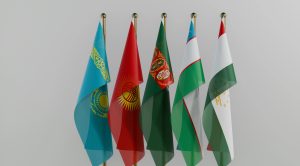The chair and ranking member of the South & Central Asia Subcommittee of the U.S. House of Representatives Foreign Affairs Committee penned a letter on October 20 urging the Trump administration to “host and personally attend a C5+1 Leaders’ Summit in Washington, D.C. this year.”
In the letter, signed by Rep. Sydney Kamlager-Dove (D-CA) and Rep. Bill Huizenga (R-MI), the members noted that the looming 10th anniversary of the C5+1 format presents “a unique opportunity to deepen relations with Central Asia and advance U.S. strategic objectives in the region.”
Launched in 2015 with a foreign minister-level summit attended by then-U.S. Secretary of State John Kerry in Samarkand, Uzbekistan on November 1, the C5+1 has come to frame much of U.S. engagement with the region. In dealing with Central Asia collectively, rather than just bilaterally, the U.S. sought to amplify its influence in the region at a time when the war in Afghanistan was drawing down but both Russia and China were becoming more active. The C5+1 fit nicely into the multivector foreign policies of most Central Asian states and dovetailed, especially after the 2016 death of Uzbekistan’s isolationist first President Islam Karimov, with increased commitment to regional cooperation.
Since 2015, the foreign ministers of the six countries – Kazakhstan, Kyrgyzstan, Tajikistan, Turkmenistan, Uzbekistan and the United States – have met nearly annually. There were foreign minister level summits in 2015 (Samarkand), 2016 (Washington), 2017 (New York), 2019 (New York), 2020 (Tashkent), 2020 (Virtual), 2021 (Virtual), 2022 (New York), 2023 (Astana) and 2024 (New York). Over the years there have been other meetings below the foreign minister level, or without the U.S. Secretary of State; in 2022 a secretariat was established.
In 2023, then-U.S. President Joe Biden took the C5+1 to a higher level, hosting a Leaders’ Summit on the sidelines of that year’s United Nations General Assembly. The year before, the C5+1 stood up a secretariat, fitting into the Biden administration’s wider efforts to institutionalize minilateral platforms it found useful for channeling engagement.
But so far in 2025, although the C5+1 has been mentioned in bilateral discussions between U.S. Secretary of State Marco Rubio and his Uzbek and Kazakh counterparts, the State Department hasn’t published a single official statement or press release specifically regarding the format to its website.
The annual U.N. General Assembly has served as a convenient time for the Central Asian foreign ministers and their U.S. counterpart to meet. But there was no C5+1 summit last month as many had anticipated.
“Given that the customary C5+1 Foreign Ministers’ meeting did not take place at the U.N. General Assembly this year, it is even more important that you host a consequential Leaders Summit, which would be the second leader-level meeting in the history of the C5+1,” the Kamlager-Dove-Huizenga letter to President Donald Trump stated.
Kamlager-Dove and Huizenga urged the Trump administration to prepare a summit and focus on “deliverables that enhance longstanding areas of cooperation in coordination with the Central Asian countries.” These areas include the C5+1 Critical Minerals Dialogue, counterterrorism cooperation, technology security, and people-to-people ties with the aim to expand U.S. soft power.
While there has been little said officially on the C5+1, the Trump administration has moved forward with high-profile deals with Uzbekistan and Kazakhstan. Trump is often characterized as deeply transactional and suspicious of multilateral engagements. The C5+1 may thus fail to find traction even as select Central Asian states break through to the administration on their own.
Complicating matters further, the second Trump administration has taken steps to downsize the U.S. government, including firing State Department employees, which will curtail the department’s capabilities and capacity. Add in the current U.S. government shutdown – stretching into its fourth week – and the odds on arranging a C5+1 leaders’ level summit anytime soon are long.
Kamlager-Dove and Huizenga nevertheless argued that a “Leaders’ Summit with meaningful outcomes will strengthen regional cooperation and maximize the diplomatic potential of the 10th anniversary, setting the tone for strengthened U.S. engagement in the region for the rest of your presidency.”
Trump is scheduled to travel to East and Southeast Asia later this week, with expected stops in Malaysia for the ASEAN Summit (October 26-27), Japan (October 27-28), and South Korea for meetings on the sidelines of the the APEC Summit (October 29-30). There’s no word on whether he’ll traipse through Central Asia on the way back to Washington,





























